As a street photographer, I’ve always been drawn to the vibrant tapestry of urban life. The bustling streets, the diverse cultures, and the raw, unfiltered moments of everyday life are what make street photography so captivating. Photography is more than just capturing images; it’s about telling stories.
In this article, I’ll share some advanced techniques I’ve learned over the years to capture the essence of urban life through my lens.
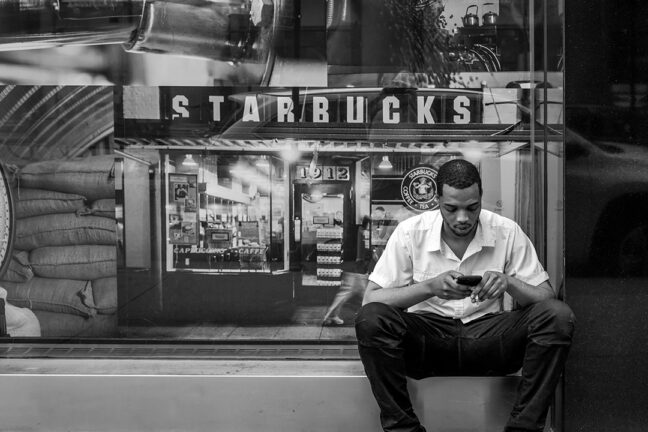
Street Photography Techniques, Settings & Composition:
Getting Started as a Street Photographer
For me, photography has been a lifelong passion that began in high school. I started in photography when they used to have darkroom classes. I took a darkroom class, and my dad let me have his Agfa camera from the Korean War, which was one of those where you push the button and it opens an accordion-like expansion called bellows. I was taking pictures the whole semester, but my pictures weren’t coming out well because there was a hole in the bellows. My teacher said my images were great, but always had an area on them that was very over-exposed. Despite this setback, I was determined to keep pushing forward into photography.
In my senior year of high school, I started shooting family portraits, and weddings. I wanted to learn as much as I could about photography, so I found a mentor, Al Buschauer, who was the top photographer in the Chicagoland area.
One day while at an eye doctor appointment, I noticed the storefront next door had amazing photography portraits displayed in the window, unlike anything I had ever seen before. After my eye exam, I went next door to ask about those images. We had a long talk and agreed that Al would mentor me. So, I went to work with him in 1979, and that’s where it started.
He used Hasselblad medium format cameras. When I looked through the viewfinder in that medium format, it was like heaven to me. So, I bought myself an old Bronica S1 that I used for years. Still my favorite camera I have ever used.
Related Posts
I moved to Chicago in 1998 to test my photography skills and began exploring street photography. While living in Chicago, I would frequent Calumet Photographic, a place that sold everything photography and rented every camera type from 35mm to 8×10 large format. I rented every camera they had and learned how to use them all. This was something I craved. The larger and crazier the camera, the more I wanted to use it. My Bronica was like a tank, and when you pushed the shutter, it made a loud snap. My kind of camera.
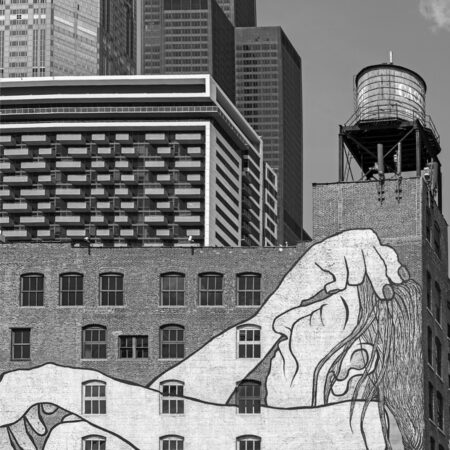
My profession at that time was an electrician in Chicago, but I hated it. I wanted to do photography. And then I read a magazine article where a landscape photographer said if you can figure out a way to go places where nobody else can go and shoot pictures, then they’ll be more valuable than just normal, everyday pictures. So I figured out how to use my electrical license to do just that, but still do my photography.
I worked for the government and traveled to different places around the world, like the Star Wars base in the Marshall Islands and the McMurdo Station in Antarctica. I brought all my cameras with me and shot the whole time I was there – after work, weekends, whenever I could. Plus my time and food were paid for by the government.
Recognition and Success
Transitioning from a hobbyist to a professional photographer wasn’t without its challenges. As I navigated the intricacies of the industry, I discovered the power of networking and self-promotion. I knew what I had to do to really sell my stuff and get bigger… but I’m not a real group-type person. I opted for a more grassroots approach, relying on gallery exhibitions and word-of-mouth referrals to showcase my work.
My work gained recognition through competitions and exhibitions. I joined camera clubs and entered my pictures in competitions, often winning top prizes.
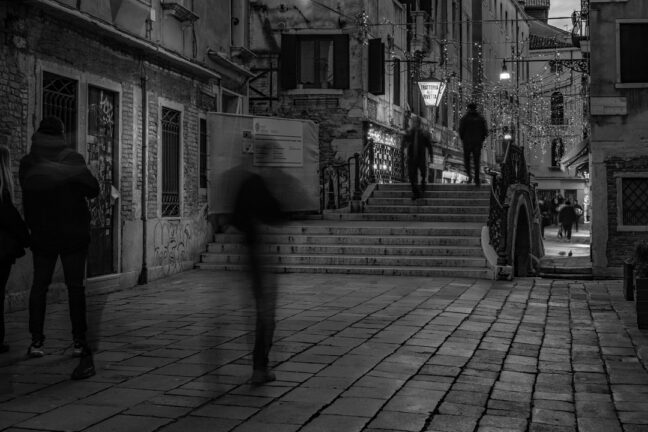
One day, I went to Starbucks in Chicago and asked if I could put one of my pictures up on the wall. They said yes, and I got calls every day about my picture. I didn’t work for a magazine; I sold my work privately and was in some galleries in Chicago, Greece, and Italy.
Related Posts
These days, I’m not much into networking or social media. I’m in my sixties, and I got ill 10 years ago. I’m partially blind and disabled, so I get social security and a pension. It’s tough out there for anybody right now. It’s like I said, if you want to get good in this business, you have to get yourself out there. You have to go and join gallery openings and meet all kinds of people. Even if you don’t have the best work out there, they might like you a lot and they’re going to give you a shot. It’s more about selling yourself than your work. I know what it takes, but I didn’t do it. I just want to do my own thing.
Gear and Settings in Different Lighting Conditions
As technology evolved, I embraced digital photography. I experimented with different lenses and settings to achieve the perfect shot. I don’t think there’s any perfect lens for photography. It has to be good quality glass. You have to buy a good-quality lens and you should be able to learn to shoot with whatever lens you have on your camera.
I use a Nikon D810 camera and good-quality lenses. The ones I like the most are 60 to maybe 90-millimeter lenses. Ones with lower apertures, to blur the background more nicely.

I don’t use automatic settings; I use manual settings. I like to keep my ISO between 100 and 200, my shutter speed around 200, and my aperture at f/2 – f/3.5 for street portraits.
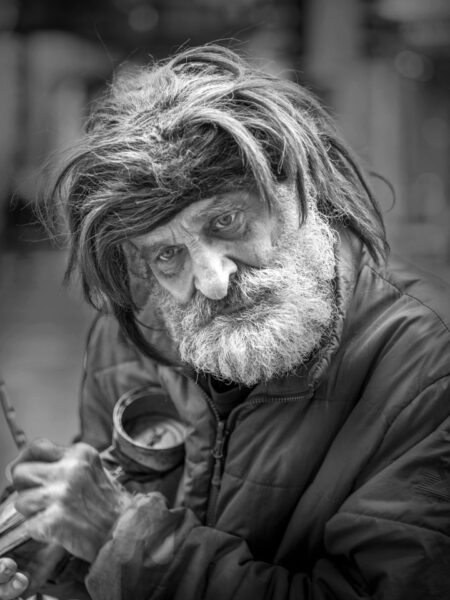
For night shots, I might increase my ISO to 650 and keep my aperture around f/9 for more light. Every lens has a sweet spot, which is usually between f/9 to f/11. You can find it by taking the same image between those f-stops, enlarging them on your computer, and comparing them.
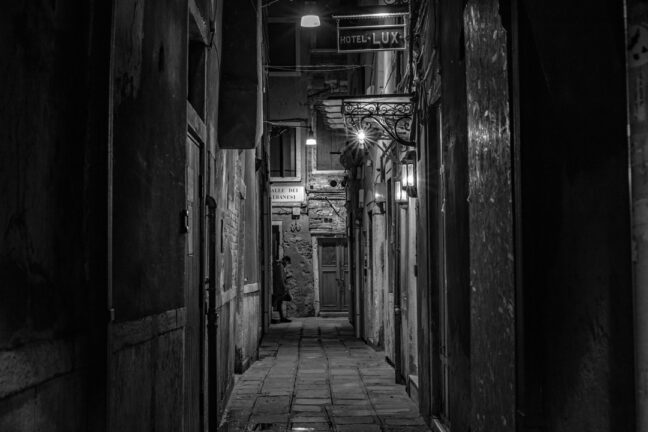
Composition Tips for Dynamic and Engaging Street Photographs
Composition is another important aspect of street photography. By using techniques such as the rule of thirds, leading lines, and framing, you can create more dynamic and engaging images.
The rule of thirds is a basic composition technique that involves dividing your frame into thirds both horizontally and vertically. By placing your subject at the intersection of these lines, you can create a more balanced and visually appealing image.
Leading lines are another powerful composition technique that can help guide the viewer’s eye through the image. Look for natural lines in your environment, such as roads or buildings, and use them to lead the viewer’s eye to your subject.
Framing is another effective way to draw attention to your subject. Look for elements within the scene, such as doorways or windows, that can be used to frame your subject and create a more interesting composition.
Lighting is another crucial way to compose your shots. Make sure the lighting isn’t too bright, or you can blow out highlights in the image. It’s always better to underexpose than overexpose, as you can open the shadows in post-processing software.
Strategies for Storytelling Through Street Photography
Finally, storytelling is an incredibly important aspect of street photography. By identifying themes and stories within the urban landscape, you can create more compelling and meaningful images.
I knew when I started my photography journey, I never wanted to be a distant observer; I wanted to engage with my subjects. I wanted my pictures to tell a story, so I started talking to people. This took me more than six months to get the courage to do. It’s not easy walking up to strangers, holding a camera in your hand. But like anything else, after a few times, it becomes much easier. Strangers can also tell when you’re nervous, but this will fade in a short time.
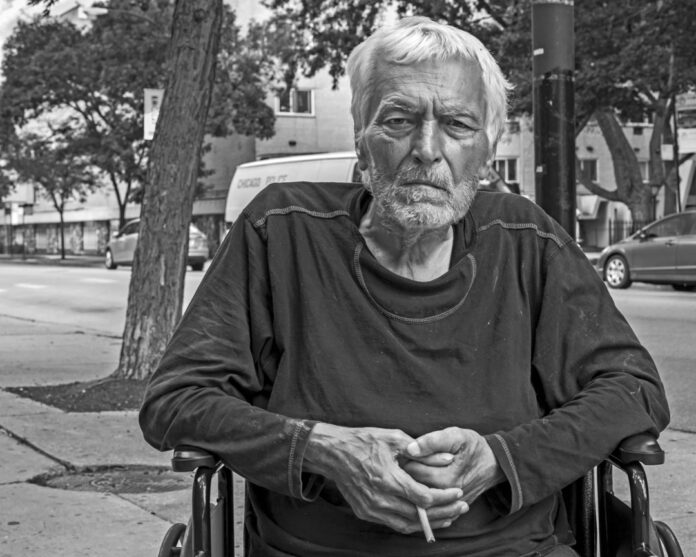
I learned that the key to capturing genuine moments was to connect with people on a personal level. I found out the best way for me was to talk to somebody, get to know who they were, and find out how genuine they were. See if they had an interesting story to tell. Emotions make the picture. The picture then tells the story.
I began building relationships with my subjects. I would approach people, strike up a conversation, and ask if I could take their picture as we talked. If they agreed, I would capture candid moments that revealed their true selves.
Making a Genuine Connection
You have to see who they are before you even want to take a picture. I mean, maybe they have an interesting face. Once I see that face, I’m like, wow, that person would really look great in a picture. Let me go and say hi. And it takes a little bit of nerves because sometimes people are a little rude and you don’t know how they’ll respond.
But once you get up that nerve and you do it the first time, the second, the third, the fourth time, it’s not that hard. I would just walk up and say, “Hey, how’s it going today? Are you staying warm?” if it’s cold out. Just normal things. “Are you keeping warm?” “How long have you been sitting here?” Just something really simple, nothing really planned out. Each person is a little bit different, depending on what they’re doing. It comes pretty naturally after that. If they’re okay to talk to you, they’ll talk to you. If they’re not, they’ll kind of look at you and you can tell if they want you to go away.
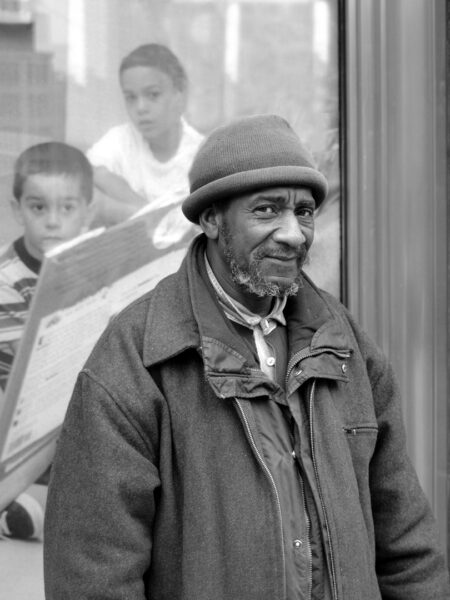
I’m not intrusive. I’m not rude. I’m not mean. But I let them know that I’m not afraid either. And if they say, “No, go away,” then I leave.
But you don’t want to show them that you’re nervous. When you finally do sit down, you talk to them, you make a connection and get them comfortable with you, then you say I would love to take your picture.
While we have a conversation, I’d say, “Do you mind if I get a couple of pictures while we talk?” I don’t want them to pose. I want it to be natural. I want the emotions that they’re telling me to come out to the camera. Sometimes, if the lighting is bad, I will ask them if we could walk to a different spot.
Louis, the Hungarian Cop
One time, I met a guy who had this overflowing shopping cart filled with his life’s possessions. He was across the street from Starbucks on the north side of Chicago. And he had this shopping cart that was full – his stuff was about five feet over the top of it and hanging off the sides. And I stopped and I said, “Wow, you have a lot of stuff here. How do you take it around?”
He looked at me and said, “Oh, those sons of a bitch cops out here.” He tells me he came from Hungary. So now he’s telling me his story, which is the cool part about my job; I get to hear all these stories.
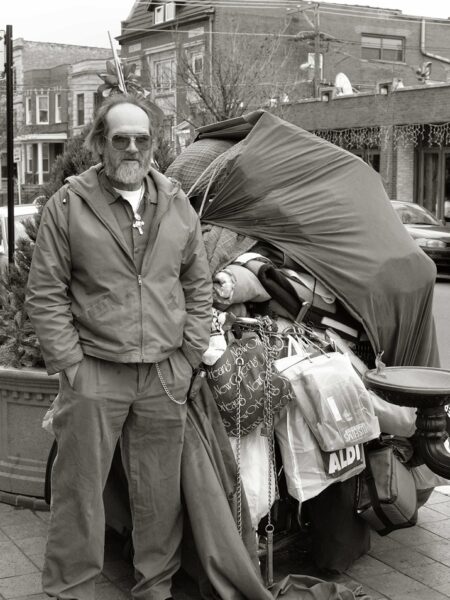
He tells me he was a policeman in Hungary. He came to the US and something happened and he lost his job and he’s homeless now on the north side of Chicago. This was probably in ’98. He was here in Chicago and he didn’t have a place to stay so he was on the street and he kept all his valuables with him and the police made him pay the parking meters because he had so much stuff.
He had to put his shopping cart on the street and pay the meter hourly. So he would tell them to go F themselves and they put him in jail. This was consistent all the time. His name was Louis.
Louis was a really cool guy. He started writing a book about his experiences on the street. I went there a few times and we’d sit and have coffee and talk about the book. You know, you get to meet people and kind of be in front of them a little bit, so it was always so interesting. I wanted to know the story. And once I got the first story, I just kept meeting different people with different stories. And it was unbelievable.
The Pursuit of Dirt Man
I lived in the South Loop of Chicago in the late 90s, which was an up-and-coming area. It was a little bit dangerous, but it was up and coming. And as I was walking around, doing my pictures, and people were talking about this guy called Dirt Man.
I go, “Who is Dirt Man?” There’s a certain population of homeless that are recluses. They don’t want to be seen. Those are the people that I wanted to find and get their stories.
I started hearing about Dirt Man from other homeless people and it made me so curious. I thought, was he really dirty? And when I asked, everyone said no, he’s so clean. Every day he gets up and washes. He’s an ex-military guy, and he’s got a really long beard and long hair, and he’s Dirt Man because he’s so clean. So I said I want to meet this guy. He lives in a place called Lower Wacker Drive in Chicago, which is an area kind of under the city where the police have their auto pound where they take your car if it’s towed and it’s kind of a scary place.
It’s like the underworld and you’ll see homeless scattered around underneath there and those are the ones who don’t want anybody to see them and those were the kind of guys I wanted to meet.
One time I went down there and it was a little shaky so I wanted to find a way to make it safer. I found a homeless man named Billy, he was probably about six foot five, 350 pounds, built like a linebacker. I asked him if he could work with me to find Dirt Man.
We walked down Lower Wacker and we would look for him and one day this one guy started screaming at me. I didn’t know if he was mentally ill or something so I said I’m with the news and I’m just documenting the Lower Wacker because I didn’t want anybody to think I was just a guy walking down the street.
I wanted him to think, we better not do anything because this guy’s with the news. But he came at me with a knife and Billy tackled him and almost killed him. I had to pull Billy off and tell him to stop beating the guy.
After that, I told Billy we can’t do this anymore. “I can’t let you kill somebody and I don’t want to get killed either,” so I had to let Billy go.
You have to be careful when you’re doing that kind of stuff too, the stuff I was doing.
Today is even more dangerous because of the drug-addicted homeless population. They are much younger and some will do whatever it takes to get money for drugs. It’s very different than it was years ago. Please be careful and smart.
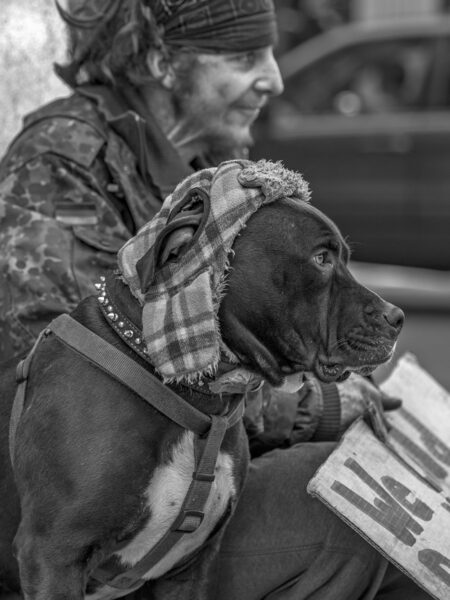
Continuing the Journey
Street photography will always be a powerful way to capture the essence of urban life. By understanding the challenges of different lighting conditions, using techniques to capture candid moments, and mastering composition and storytelling, you can create stunning images that truly reflect the soul of the city.
Today, I’m exploring new frontiers in photography. I’m getting into AI photography, my street photography combined with AI. I’m kind of mixing them both together like a little mixed media thing and playing with that. I’m doing a funnier side on street photography now. I just want to change the whole thing, do something a little different.
Check out some of my new AI work on my Instagram @darkroomchops. And be sure to follow and comment – I’d love to know what you think!
Disclosure/Disclaimer: As an Amazon Associate, we earn from qualifying purchases. Certain content was provided "as is" from Amazon and is subject to change or removal at any time. Product prices and availability: Amazon prices are updated daily or are accurate as of the date/time indicated and are subject to change. Any price and availability information displayed on Amazon.com at the time of purchase will apply to the purchase of this product.
